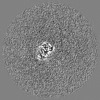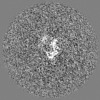+ Open data
Open data
- Basic information
Basic information
| Entry | Database: EMDB / ID: EMD-22696 | |||||||||
|---|---|---|---|---|---|---|---|---|---|---|
| Title | antibody and nucleosome complex | |||||||||
 Map data Map data | antibody and nucleosome complex | |||||||||
 Sample Sample |
| |||||||||
 Keywords Keywords | nucleosome / DNA BINDING PROTEIN / DNA BINDING PROTEIN-DNA complex | |||||||||
| Function / homology |  Function and homology information Function and homology informationHATs acetylate histones / RNA polymerase I upstream activating factor complex / Condensation of Prophase Chromosomes / SIRT1 negatively regulates rRNA expression / Activated PKN1 stimulates transcription of AR (androgen receptor) regulated genes KLK2 and KLK3 / Assembly of the ORC complex at the origin of replication / HDACs deacetylate histones / Recruitment and ATM-mediated phosphorylation of repair and signaling proteins at DNA double strand breaks / Oxidative Stress Induced Senescence / RMTs methylate histone arginines ...HATs acetylate histones / RNA polymerase I upstream activating factor complex / Condensation of Prophase Chromosomes / SIRT1 negatively regulates rRNA expression / Activated PKN1 stimulates transcription of AR (androgen receptor) regulated genes KLK2 and KLK3 / Assembly of the ORC complex at the origin of replication / HDACs deacetylate histones / Recruitment and ATM-mediated phosphorylation of repair and signaling proteins at DNA double strand breaks / Oxidative Stress Induced Senescence / RMTs methylate histone arginines / DNA damage tolerance / SUMOylation of chromatin organization proteins / RNA Polymerase I Promoter Escape / positive regulation of transcription by RNA polymerase I / nucleolar large rRNA transcription by RNA polymerase I / Estrogen-dependent gene expression / Ub-specific processing proteases / structural constituent of chromatin / heterochromatin formation / nucleosome / nucleosome assembly / chromatin organization / protein heterodimerization activity / DNA repair / regulation of DNA-templated transcription / negative regulation of transcription by RNA polymerase II / DNA binding / identical protein binding / nucleus Similarity search - Function | |||||||||
| Biological species |    | |||||||||
| Method | single particle reconstruction / cryo EM / Resolution: 3.1 Å | |||||||||
 Authors Authors | Ruifang G / Yawen B | |||||||||
 Citation Citation |  Journal: Nat Commun / Year: 2021 Journal: Nat Commun / Year: 2021Title: Structural and dynamic mechanisms of CBF3-guided centromeric nucleosome formation. Authors: Ruifang Guan / Tengfei Lian / Bing-Rui Zhou / Emily He / Carl Wu / Martin Singleton / Yawen Bai /   Abstract: Accurate chromosome segregation relies on the specific centromeric nucleosome-kinetochore interface. In budding yeast, the centromere CBF3 complex guides the deposition of CENP-A, an H3 variant, to ...Accurate chromosome segregation relies on the specific centromeric nucleosome-kinetochore interface. In budding yeast, the centromere CBF3 complex guides the deposition of CENP-A, an H3 variant, to form the centromeric nucleosome in a DNA sequence-dependent manner. Here, we determine the structures of the centromeric nucleosome containing the native CEN3 DNA and the CBF3core bound to the canonical nucleosome containing an engineered CEN3 DNA. The centromeric nucleosome core structure contains 115 base pair DNA including a CCG motif. The CBF3core specifically recognizes the nucleosomal CCG motif through the Gal4 domain while allosterically altering the DNA conformation. Cryo-EM, modeling, and mutational studies reveal that the CBF3core forms dynamic interactions with core histones H2B and CENP-A in the CEN3 nucleosome. Our results provide insights into the structure of the budding yeast centromeric nucleosome and the mechanism of its assembly, which have implications for analogous processes of human centromeric nucleosome formation. | |||||||||
| History |
|
- Structure visualization
Structure visualization
| Movie |
 Movie viewer Movie viewer |
|---|---|
| Structure viewer | EM map:  SurfView SurfView Molmil Molmil Jmol/JSmol Jmol/JSmol |
| Supplemental images |
- Downloads & links
Downloads & links
-EMDB archive
| Map data |  emd_22696.map.gz emd_22696.map.gz | 49.4 MB |  EMDB map data format EMDB map data format | |
|---|---|---|---|---|
| Header (meta data) |  emd-22696-v30.xml emd-22696-v30.xml emd-22696.xml emd-22696.xml | 16 KB 16 KB | Display Display |  EMDB header EMDB header |
| Images |  emd_22696.png emd_22696.png | 167.6 KB | ||
| Filedesc metadata |  emd-22696.cif.gz emd-22696.cif.gz | 5.8 KB | ||
| Archive directory |  http://ftp.pdbj.org/pub/emdb/structures/EMD-22696 http://ftp.pdbj.org/pub/emdb/structures/EMD-22696 ftp://ftp.pdbj.org/pub/emdb/structures/EMD-22696 ftp://ftp.pdbj.org/pub/emdb/structures/EMD-22696 | HTTPS FTP |
-Validation report
| Summary document |  emd_22696_validation.pdf.gz emd_22696_validation.pdf.gz | 573.5 KB | Display |  EMDB validaton report EMDB validaton report |
|---|---|---|---|---|
| Full document |  emd_22696_full_validation.pdf.gz emd_22696_full_validation.pdf.gz | 573 KB | Display | |
| Data in XML |  emd_22696_validation.xml.gz emd_22696_validation.xml.gz | 6 KB | Display | |
| Data in CIF |  emd_22696_validation.cif.gz emd_22696_validation.cif.gz | 6.9 KB | Display | |
| Arichive directory |  https://ftp.pdbj.org/pub/emdb/validation_reports/EMD-22696 https://ftp.pdbj.org/pub/emdb/validation_reports/EMD-22696 ftp://ftp.pdbj.org/pub/emdb/validation_reports/EMD-22696 ftp://ftp.pdbj.org/pub/emdb/validation_reports/EMD-22696 | HTTPS FTP |
-Related structure data
| Related structure data | 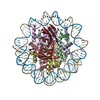 7k78MC  7k79C  7k7gC M: atomic model generated by this map C: citing same article ( |
|---|---|
| Similar structure data |
- Links
Links
| EMDB pages |  EMDB (EBI/PDBe) / EMDB (EBI/PDBe) /  EMDataResource EMDataResource |
|---|---|
| Related items in Molecule of the Month |
- Map
Map
| File |  Download / File: emd_22696.map.gz / Format: CCP4 / Size: 52.7 MB / Type: IMAGE STORED AS FLOATING POINT NUMBER (4 BYTES) Download / File: emd_22696.map.gz / Format: CCP4 / Size: 52.7 MB / Type: IMAGE STORED AS FLOATING POINT NUMBER (4 BYTES) | ||||||||||||||||||||||||||||||||||||||||||||||||||||||||||||||||||||
|---|---|---|---|---|---|---|---|---|---|---|---|---|---|---|---|---|---|---|---|---|---|---|---|---|---|---|---|---|---|---|---|---|---|---|---|---|---|---|---|---|---|---|---|---|---|---|---|---|---|---|---|---|---|---|---|---|---|---|---|---|---|---|---|---|---|---|---|---|---|
| Annotation | antibody and nucleosome complex | ||||||||||||||||||||||||||||||||||||||||||||||||||||||||||||||||||||
| Projections & slices | Image control
Images are generated by Spider. | ||||||||||||||||||||||||||||||||||||||||||||||||||||||||||||||||||||
| Voxel size | X=Y=Z: 1.06 Å | ||||||||||||||||||||||||||||||||||||||||||||||||||||||||||||||||||||
| Density |
| ||||||||||||||||||||||||||||||||||||||||||||||||||||||||||||||||||||
| Symmetry | Space group: 1 | ||||||||||||||||||||||||||||||||||||||||||||||||||||||||||||||||||||
| Details | EMDB XML:
CCP4 map header:
| ||||||||||||||||||||||||||||||||||||||||||||||||||||||||||||||||||||
-Supplemental data
- Sample components
Sample components
-Entire : scFv and nucleosome complex
| Entire | Name: scFv and nucleosome complex |
|---|---|
| Components |
|
-Supramolecule #1: scFv and nucleosome complex
| Supramolecule | Name: scFv and nucleosome complex / type: complex / ID: 1 / Parent: 0 / Macromolecule list: #1-#7 |
|---|---|
| Source (natural) | Organism:  |
-Macromolecule #1: Cse4
| Macromolecule | Name: Cse4 / type: protein_or_peptide / ID: 1 / Number of copies: 2 / Enantiomer: LEVO |
|---|---|
| Source (natural) | Organism:  |
| Molecular weight | Theoretical: 15.791588 KDa |
| Recombinant expression | Organism:  Escherichia phage EcSzw-2 (virus) Escherichia phage EcSzw-2 (virus) |
| Sequence | String: MARTKQTARK STGGKAPRKQ LASKAARKSA PSTGGVKKPK KYTPSELALY EIRKYQRSTD LLISKIPFAR LVKEVTDEFT TKDQDLRWQ SMAIMALQEA SEAYLVGLLE HTNLLALHAK RITIMKKDMQ LARRIRGQFI |
-Macromolecule #2: Histone H4
| Macromolecule | Name: Histone H4 / type: protein_or_peptide / ID: 2 / Number of copies: 2 / Enantiomer: LEVO |
|---|---|
| Source (natural) | Organism:  Strain: ATCC 204508 / S288c |
| Molecular weight | Theoretical: 11.39539 KDa |
| Recombinant expression | Organism:  Escherichia phage EcSzw-2 (virus) Escherichia phage EcSzw-2 (virus) |
| Sequence | String: MSGRGKGGKG LGKGGAKRHR KILRDNIQGI TKPAIRRLAR RGGVKRISGL IYEEVRAVLK SFLESVIRDS VTYTEHAKRK TVTSLDVVY ALKRQGRTLY GFGG UniProtKB: Histone H4 |
-Macromolecule #3: Histone H2A.1
| Macromolecule | Name: Histone H2A.1 / type: protein_or_peptide / ID: 3 / Number of copies: 2 / Enantiomer: LEVO |
|---|---|
| Source (natural) | Organism:  Strain: ATCC 204508 / S288c |
| Molecular weight | Theoretical: 14.013177 KDa |
| Recombinant expression | Organism:  Escherichia phage EcSzw-2 (virus) Escherichia phage EcSzw-2 (virus) |
| Sequence | String: MSGGKGGKAG SAAKASQSRS AKAGLTFPVG RVHRLLRRGN YAQRIGSGAP VYLTAVLEYL AAEILELAGN AARDNKKTRI IPRHLQLAI RNDDELNKLL GNVTIAQGGV LPNIHQNLLP KKSAKATKAS QEL UniProtKB: Histone H2A.1 |
-Macromolecule #4: Histone H2B.1
| Macromolecule | Name: Histone H2B.1 / type: protein_or_peptide / ID: 4 / Number of copies: 2 / Enantiomer: LEVO |
|---|---|
| Source (natural) | Organism:  Strain: ATCC 204508 / S288c |
| Molecular weight | Theoretical: 14.280362 KDa |
| Recombinant expression | Organism:  Escherichia phage EcSzw-2 (virus) Escherichia phage EcSzw-2 (virus) |
| Sequence | String: MSAKAEKKPA SKAPAEKKPA AKKTSTSTDG KKRSKARKET YSSYIYKVLK QTHPDTGISQ KSMSILNSFV NDIFERIATE ASKLAAYNK KSTISAREIQ TAVRLILPGE LAKHAVSEGT RAVTKYSSST QA UniProtKB: Histone H2B.1 |
-Macromolecule #7: scFv
| Macromolecule | Name: scFv / type: protein_or_peptide / ID: 7 / Number of copies: 2 / Enantiomer: LEVO |
|---|---|
| Source (natural) | Organism:  |
| Molecular weight | Theoretical: 29.030146 KDa |
| Recombinant expression | Organism:  Escherichia phage EcSzw-2 (virus) Escherichia phage EcSzw-2 (virus) |
| Sequence | String: MKSSHHHHHH ENLYFQSNAM EVQLQQSGPE LVEPGTSVKM PCKASGYTFT SYTIQWVKQT PRQGLEWIGY IYPYNAGTKY NEKFKGKAT LTSDKSSSTV YMELSSLTSE DSAVYYCARK SSRLRSTLDY WGQGTSVTVS SGGGGSGGGG SGGGGSMDIK M TQSPSSMH ...String: MKSSHHHHHH ENLYFQSNAM EVQLQQSGPE LVEPGTSVKM PCKASGYTFT SYTIQWVKQT PRQGLEWIGY IYPYNAGTKY NEKFKGKAT LTSDKSSSTV YMELSSLTSE DSAVYYCARK SSRLRSTLDY WGQGTSVTVS SGGGGSGGGG SGGGGSMDIK M TQSPSSMH ASLGERVTIT CKASQDIRSY LSWYQQKPWK SPKTLIYYAT SLADGVPSRF SGSGSGQDFS LTINNLESDD TA TYYCLQH GESPYTFGSG TKLEIKRA |
-Macromolecule #5: DNA (136-MER)
| Macromolecule | Name: DNA (136-MER) / type: dna / ID: 5 / Number of copies: 1 / Classification: DNA |
|---|---|
| Source (natural) | Organism:  |
| Molecular weight | Theoretical: 42.219285 KDa |
| Sequence | String: (DT)(DC)(DG)(DG)(DG)(DT)(DC)(DA)(DC)(DA) (DT)(DG)(DA)(DT)(DG)(DA)(DT)(DA)(DT)(DT) (DT)(DG)(DA)(DT)(DT)(DT)(DT)(DA)(DT) (DT)(DA)(DT)(DA)(DT)(DT)(DT)(DT)(DT)(DA) (DA) (DA)(DA)(DA)(DA)(DA)(DG) ...String: (DT)(DC)(DG)(DG)(DG)(DT)(DC)(DA)(DC)(DA) (DT)(DG)(DA)(DT)(DG)(DA)(DT)(DA)(DT)(DT) (DT)(DG)(DA)(DT)(DT)(DT)(DT)(DA)(DT) (DT)(DA)(DT)(DA)(DT)(DT)(DT)(DT)(DT)(DA) (DA) (DA)(DA)(DA)(DA)(DA)(DG)(DT)(DA) (DA)(DA)(DA)(DA)(DA)(DT)(DA)(DA)(DA)(DA) (DA)(DG) (DT)(DA)(DG)(DT)(DT)(DT)(DA) (DT)(DT)(DT)(DT)(DT)(DA)(DA)(DA)(DA)(DA) (DA)(DT)(DA) (DA)(DA)(DA)(DT)(DT)(DT) (DA)(DA)(DA)(DA)(DT)(DA)(DT)(DT)(DA)(DG) (DT)(DG)(DT)(DA) (DT)(DT)(DT)(DG)(DA) (DT)(DT)(DT)(DC)(DC)(DG)(DA)(DA)(DA)(DG) (DT)(DT)(DA)(DA)(DA) (DA)(DA)(DA)(DG) (DA)(DA)(DA)(DT)(DA)(DG)(DT)(DA)(DA)(DG) (DC)(DT) |
-Macromolecule #6: DNA (136-MER)
| Macromolecule | Name: DNA (136-MER) / type: dna / ID: 6 / Number of copies: 1 / Classification: DNA |
|---|---|
| Source (natural) | Organism:  |
| Molecular weight | Theoretical: 41.679848 KDa |
| Sequence | String: (DA)(DG)(DC)(DT)(DT)(DA)(DC)(DT)(DA)(DT) (DT)(DT)(DC)(DT)(DT)(DT)(DT)(DT)(DT)(DA) (DA)(DC)(DT)(DT)(DT)(DC)(DG)(DG)(DA) (DA)(DA)(DT)(DC)(DA)(DA)(DA)(DT)(DA)(DC) (DA) (DC)(DT)(DA)(DA)(DT)(DA) ...String: (DA)(DG)(DC)(DT)(DT)(DA)(DC)(DT)(DA)(DT) (DT)(DT)(DC)(DT)(DT)(DT)(DT)(DT)(DT)(DA) (DA)(DC)(DT)(DT)(DT)(DC)(DG)(DG)(DA) (DA)(DA)(DT)(DC)(DA)(DA)(DA)(DT)(DA)(DC) (DA) (DC)(DT)(DA)(DA)(DT)(DA)(DT)(DT) (DT)(DT)(DA)(DA)(DA)(DT)(DT)(DT)(DT)(DA) (DT)(DT) (DT)(DT)(DT)(DT)(DA)(DA)(DA) (DA)(DA)(DT)(DA)(DA)(DA)(DC)(DT)(DA)(DC) (DT)(DT)(DT) (DT)(DT)(DA)(DT)(DT)(DT) (DT)(DT)(DT)(DA)(DC)(DT)(DT)(DT)(DT)(DT) (DT)(DT)(DA)(DA) (DA)(DA)(DA)(DT)(DA) (DT)(DA)(DA)(DT)(DA)(DA)(DA)(DA)(DT)(DC) (DA)(DA)(DA)(DT)(DA) (DT)(DC)(DA)(DT) (DC)(DA)(DT)(DG)(DT)(DG)(DA)(DC)(DC)(DC) (DG)(DA) |
-Experimental details
-Structure determination
| Method | cryo EM |
|---|---|
 Processing Processing | single particle reconstruction |
| Aggregation state | particle |
- Sample preparation
Sample preparation
| Buffer | pH: 7.3 |
|---|---|
| Vitrification | Cryogen name: NITROGEN / Chamber humidity: 100 % |
- Electron microscopy
Electron microscopy
| Microscope | FEI TITAN KRIOS |
|---|---|
| Image recording | Film or detector model: GATAN K2 SUMMIT (4k x 4k) / Average electron dose: 71.0 e/Å2 |
| Electron beam | Acceleration voltage: 300 kV / Electron source:  FIELD EMISSION GUN FIELD EMISSION GUN |
| Electron optics | Illumination mode: SPOT SCAN / Imaging mode: BRIGHT FIELD |
| Experimental equipment | 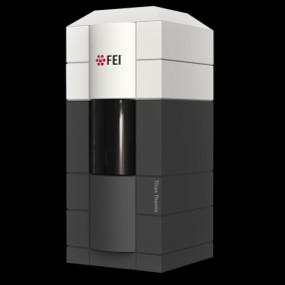 Model: Titan Krios / Image courtesy: FEI Company |
- Image processing
Image processing
| Startup model | Type of model: PDB ENTRY |
|---|---|
| Final reconstruction | Resolution.type: BY AUTHOR / Resolution: 3.1 Å / Resolution method: FSC 0.143 CUT-OFF / Number images used: 143164 |
| Initial angle assignment | Type: MAXIMUM LIKELIHOOD |
| Final angle assignment | Type: MAXIMUM LIKELIHOOD |
 Movie
Movie Controller
Controller




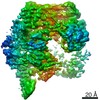

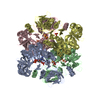









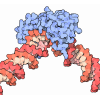
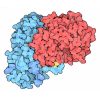
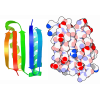
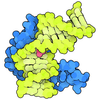

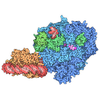

 Z (Sec.)
Z (Sec.) Y (Row.)
Y (Row.) X (Col.)
X (Col.)









